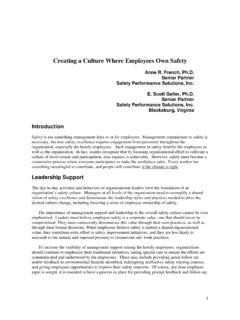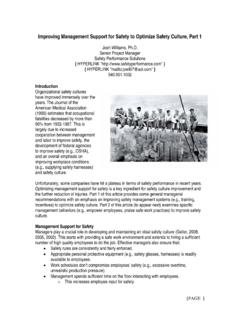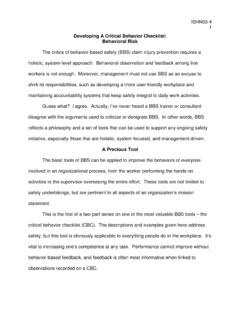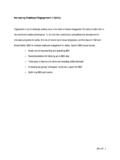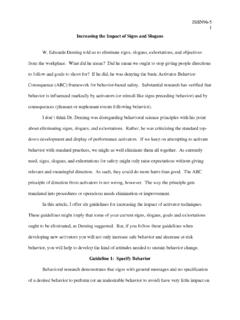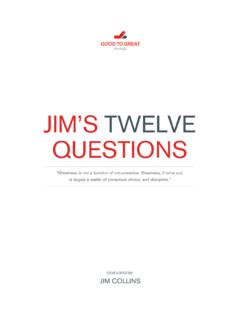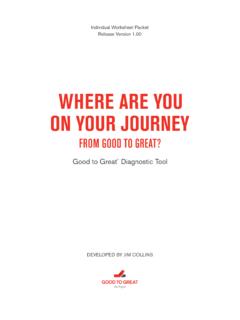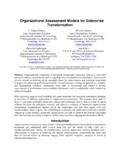Transcription of World Class in Safety - Safety Performance
1 ISHN05-3 1. World Class in Safety : What Does it Take? good is the enemy of great jim collins , 2001 Recently, the CEO of a leading chemical company told me he dislikes the term World - Class Safety , because its meaning is so ambiguous. Everyone talks about wanting a World - Class Safety program, but nobody provides a straightforward definition of this vision. What does it mean to be World Class ? This and my next two contributions to ISHN attempt to answer this CEO s provocative question. My answer does not come from common sense, but from over five years of empirical research. As reported in the book, From good to great (2001, Harper Collins, NY), jim collins and his research team studied eleven companies that transitioned from being good to being great sustaining this level of excellence for at least 15 years.
2 They systematically compared these good -to- great companies with a carefully selected set of eleven companies that maintained good productivity and profits for at least 15 years, but never made the leap from good to great . Collins and his research team found a number of common qualities among the good -to- great companies not consistently observed at the comparison companies. I share these qualities in this series of ISHN articles and relate them to Safety . These good -to- great qualities not only imply an operational definition of World Class Safety , but also suggest ways to achieve this enviable level of Safety excellence. ISHN05-3 2. Start with the Right People Claiming it s who you pay, not how you pay them, Collins places substantial focus on employing the right people.
3 He uses the metaphor of a bus, emphasizing the need to get the right people on the bus in the first place and to keep them there (p. 50). His research team concluded that character, work ethic, conscientiousness, and values are more important than educational background, practical skills, specialized knowledge, and work experience. The latter attributes are teachable and changeable, whereas the former are presumably more permanent traits. This point relates directly to my ISHN articles last year on personality and Safety (see especially the May & July, 2004 issues of ISHN). Collins also concludes letting the wrong people stay around is unfair to all the right people, as they inevitably find themselves compensating for the inadequacies of the wrong people (p.)
4 56). It s also unfair to hire a wrong person, with intentions to let them go later. The best performers are motivated by the intrinsic or natural consequences of their job. If people do not find such satisfaction in their job, it s in the best interest of all involved to let them go early or find them another assignment. This relates to another key conclusion of Collins research team. Put People in the Right Positions Once you have the right people on your bus, it s essential to put each person in the right seats. As with team sports, this means matching job function with individual talent. Collins indicates it can take time to determine whether less-than- great Performance means a person is merely in the wrong seat on the ISHN05-3 3.
5 Bus or needs to get off the bus altogether. Such decisions require ongoing assessment through behavioral observation, as well as interpersonal conversation and coaching. When people are performing work that matches their talent and interest, they get intrinsic or natural gratification from their work. Collins research team did not find any impact of financial compensation on whether a company shifts from good to great . They concluded that the purpose of compensation is not to motivate the right behaviors from the wrong people, but to get and keep the right people in the first place (p. 64). Confront Brutal Facts Through Open Communication It might seem harsh to get wrong people off the bus, and to move people from one seat to another.
6 Yet for the good -to- great companies this is merely consistent with a work culture in which employees engage in rigorous debate, analysis, and continuous learning to uncover and report the objective facts of current reality. A climate of truth telling is created in part by supervisors leading with questions -- not answers, and seeking facts -- not faults. Collins reports the good -to- great companies deal with as much adversity as the comparison companies. The difference is the good -to- great companies uncover the brutal facts of the situation and confront them head-on. The result: They emerge from their troubles stronger than before. Relevance to Industrial Safety Are these special qualities of good -to- great companies relevant to defining a World - Class Safety organization?
7 I think so, but bear in mind we are talking ISHN05-3 4. about the qualities of an ideal Total Safety Culture. These qualities reflect Safety ideals toward which we should aspire. Rarely, if ever, are these exemplary criteria achieved throughout an entire workplace. Most obvious to me is the last point maintaining a climate where the truth is heard. A World - Class Safety work force discusses freely and openly, without embarrassment, all injuries (minor and major), as well as close calls. The workers realize that only through such open discussion can the environmental, behavioral, and cultural factors contributing to these mishaps be identified and removed or corrected. Facing such adversity head-on results in a work force more prepared to prevent occupational injuries.
8 What is the Safety relevance of getting the right people on the bus and in the right seats? At a workshop I gave last December to 90 first-line supervisors, the plant manager urged me to emphasize this particular lesson. He wanted his supervisors to realize that workers may not be doing the job for which they are most suited, and this could be a Safety hazard. And in some cases, an employee or contractor may not care about Safety to the degree demanded by the work culture. He wanted his supervisors to look for these incongruities and then engage in open and frank conversation with individuals whose at-risk behaviors suggest they are not prepared or appropriate for a particular job. To achieve World - Class in Safety , work cultures need to help people face the brutal fact that their at-risk behavior is inconsistent with a workplace that promotes Safety as a core value.
9 This does not necessarily mean the person ISHN05-3 5. should get off the bus, but it does mean some corrective action is required. The sooner in a person s tenure with a company this issue is addressed, the better. Safety organizations aspiring to be World - Class give specific Safety -related expectations during worker orientation. New workers are observed carefully during this orientation period to determine compatibility between job function and individual talents, interests, and values. When workers behaviors suggest they do not hold Safety as a value, they receive corrective action, which includes at least an open and frank conversation with an appropriate supervisor. If they choose to stay on the bus, the workers derive a detailed corrective-action plan in which they commit to certain behavior change and specify any peer or management support they need to make this happen (see my April 1994 ISHN column for more details on positive discipline.)
10 In Conclusion This presentation is the first in a three-part series on exploring what it takes to be World - Class in industrial Safety . The stringent criteria are gleaned from a national bestseller that stipulated the qualities of eleven elite companies that made the leap from good to great results, and sustained greatness for at least 15 years. The qualities addressed here are: 1) get the right people on the job, 2) get the wrong people off the job, 3) match talent and interest with job operations, 4) maintain a climate of truth telling by engaging people in rigorous debate, analysis, and continuous learning, and 5) confront the facts, even when they are harsh. ISHN05-3 6. For World - Class Safety , these criteria imply a need for open, frank, and fact-finding conversations about all Safety -related incidents, from close calls and first-aid cases to the most serious injuries and fatalities.
